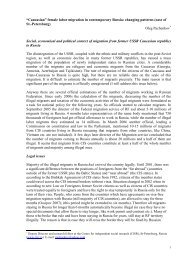THORIUM AS AN ENERGY SOURCE - Opportunities for Norway ...
THORIUM AS AN ENERGY SOURCE - Opportunities for Norway ...
THORIUM AS AN ENERGY SOURCE - Opportunities for Norway ...
Create successful ePaper yourself
Turn your PDF publications into a flip-book with our unique Google optimized e-Paper software.
Nuclear Reactors <strong>for</strong> Thorium<br />
material selection <strong>for</strong> the internal core structures, the spallation target and fuel cladding<br />
the sub-critical core design<br />
obtaining nuclear data <strong>for</strong> achieving a reliable design<br />
The need <strong>for</strong> an experimental ADS in Europe and its objectives: In order to develop and test the<br />
technology <strong>for</strong> commercial deployment of accelerator driven systems, an experimental facility is<br />
required. This facility should in pilot scale prove the feasibility of operating a sub-critical reactor<br />
driven by a high intensity accelerator. It is needed to demonstrate the long-term applicability of<br />
corrosion control in lead-bismuth cooled reactors. It should further provide the fast neutron<br />
environment necessary <strong>for</strong> developing minor actinide based transmutation fuels. The availability<br />
of a fast neutron spectrum will be mandatory <strong>for</strong> development of more irradiation resistant<br />
structural materials that can increase the operational lifetime of commercial ADS or new<br />
generation critical reactors to be deployed in the future.<br />
The experimental ADS can also be conceived with less demanding working condition in terms of<br />
facility rate availability (50 to 70 %) as compared to the one that would be envisaged <strong>for</strong> an<br />
industrial transmuter (70 to 90 %). Such a reasonable, but nevertheless acceptable, availability<br />
rate would allow accommodating the beam trips expected <strong>for</strong> the first-of-kind machine to be<br />
deployed. This will then allow improving the accelerator per<strong>for</strong>mance progressively towards the<br />
per<strong>for</strong>mances to be achieved <strong>for</strong> the industrial ADS.<br />
The domain of interest of such experiment will be to show a reliable operation of the system, from<br />
start-up to nominal power level, up to shutdown, in presence of thermal reactor feedback effects.<br />
The presence of control rods in the system will allow verifying different modes of operation during<br />
fuel irradiation and the determination and monitoring of reactivity levels with “ad-hoc”<br />
techniques. The joint cooling of the target and of the sub-critical core will be demonstrated,<br />
together with the solution of some practical engineering problems of generic interest <strong>for</strong> an ADS,<br />
such as the configuration of the beam ingress into the core.<br />
The possibility to run the experiment at different levels of sub-criticality and power ratings<br />
(realised e.g. with appropriate fuel loading patterns), will allow to explore experimentally the<br />
transition from an “external” source-dominated regime to a core thermal feedback-dominated<br />
regime. This transition is relevant, in particular to understand the dynamic behaviour of an ADS,<br />
which, in the future full scale demonstrations of transmutation, could have both a very low βeff<br />
and very low Doppler reactivity effect.<br />
One important project conducted at the Belgian Nuclear Research Centre (SCK-CEN) is the<br />
MYRRHA project. It aims to serve as a basis <strong>for</strong> the European experimental demonstration of<br />
transmutation in ADS and to provide protons and neutrons <strong>for</strong> various R&D applications. It<br />
consists of a proton accelerator delivering a 600 MeV, 2.5 mA (or 350 MeV, 5 mA) proton beam to<br />
a liquid Pb-Bi spallation target that in turn couples to a Pb-Bi cooled, subcritical fast nuclear<br />
core. The project started in 1997 and the aim is to put MYRRHA in service in 2016 - 2018.<br />
Additional in<strong>for</strong>mation: [127], [128], [129], [130], [131], [132] and [133].<br />
5.4.4.10 Roadmap <strong>for</strong> an Experimental ADS in Europe<br />
The roadmap presented in April 2001 by the Extended (actually European) Technical Working<br />
Group (ETWG): “A European Roadmap <strong>for</strong> Developing Accelerator Driven Systems <strong>for</strong> Nuclear<br />
Waste Incineration”, assumes that a major financial investment made as early as 2003, which was<br />
the scheduled year of the beginning of the FP6 (255 M€ over 4 years <strong>for</strong> R&D, engineering <strong>for</strong> the<br />
Detailed Preliminary-Design and the beginning of construction). This financial investment has<br />
69

















